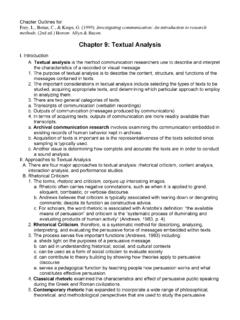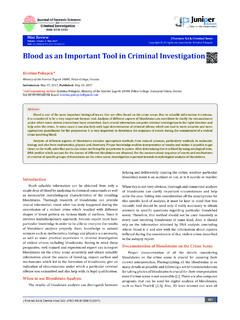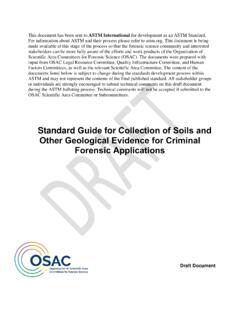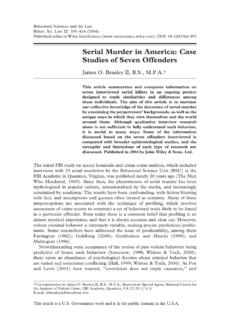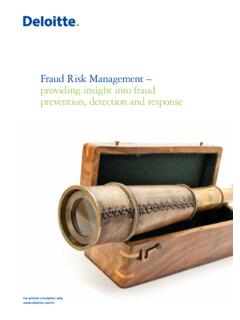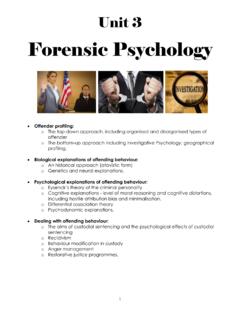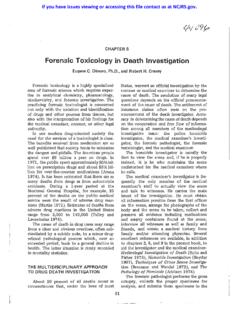Transcription of Criminal Profiling from Crime Scene Analysis
1 Presents Criminal Profiling from Crime Scene Analysis (John E. Douglas, Robert K. Ressler, Ann W. Burgess, Carol R. Hartman) Released by the Department of Justice as part of the information on serial killers provided by the FBI's Training Division and Behavioral Science Unit at Quantico, Virginia. (Originally published in 1986) 1 Since the 1970s, investigative profilers at the FBI's Behavioral Science Unit (now part of the National Center for the Analysis of Violent Crime ) have been assisting local, state, and federal agencies in narrowing investigations by providing Criminal personality profiles. An attempt is now being made to describe this Criminal -profile-generating process. A series of five overlapping stages lead to the sixth stage, or the goal of apprehension of the offender: (1) Profiling inputs, (2) decision-process models, (3) Crime assessment, (4) the Criminal profile, (5) investigation, and (6) apprehension.
2 Two key feedback filters in the process are: (a) achieving congruence with the evidence, with decision models, and with investigation recommendations, and (6) the addition of new evidence. "You wanted to mock yourself at me! .. You did not know your Hercule Poirot." He thrust out his chest and twirled his moustache. I looked at him and grinned .. "All right then," I said. "Give us the answer to the problems - if you know it." "But of course I know it." Hardcastle stared at him "Excuse me. Monsieur Poirot, you claim that you know who killed three people. And why?..All you mean is that you have a hunch" I will not quarrel with you over a now. Inspector. I know really perceive you are still sceptic. But first let me say this. To be sure means that when the right solution is reached, everything falls into place. You perceive that in no other way could things have happened.
3 " (Christie 1963. pp. 227-228). The ability of Hercule Poirot to solve a Crime by describing the perpetrator is a skill shared by the expert investigative profiler. Evidence speaks its own language of patterns and sequences that can reveal the offender's behavioral characteristics. Like Poirot, the profiler can say . "I know who he must be." This article focuses on the developing technique of Criminal Profiling . Special agents at the FBI Academy have demonstrated expertise in Crime Scene Analysis of various violent crimes, particularly those involving sexual homicide. This article discusses the history of Profiling and the Criminal -profile-generating process and provides a case example to illustrate the technique. INTRODUCTION: HISTORY OF Criminal Profiling Criminal Profiling has been used successfully by law enforcement in several areas and is a valued means by which to narrow the field of investigation.
4 Profiling does not provide the specific identity of the offender. Rather, it indicates the kind of person most likely to have committed a Crime by focusing on certain behavioral and personality characteristics. Profiling techniques have been used in various settings such as hostage taking (Reiser. 1982). Law enforcement officers need to learn as much as possible about the hostage taker in order to protect the lives of the hostages. In such cases, police are aided by verbal contact (although often limited) with the offender and possibly by access to his family and friends. They must be able to assess the subject in terms of what course of action he is likely to take and what his reactions to various stimuli might be. 2 Profiling has been used also in identifying anonymous letter writers (Casey-Owens 1983) and persons who make written or spoken threats of violence (Miron & Douglas 1979).
5 In cases of the latter psycholinguistic techniques have been used to compose a "threat dictionary." whereby every word in a message is assigned by computer, to a specific category. Words as they are used in the threat message are then compared with those words as they are used in ordinary speech or writings. The vocabulary usage in the message may yield "signature" words unique to the offender. In this way, police may not only be able to determine that several letters were written by the same individual, but also to learn about the background and psychology of the offender. Rapists and arsonists also lend themselves to Profiling techniques. Through careful interview of the rape victim about the rapist's behaviour law enforcement personnel begin to build a profile of the offender (Hazelwood. 1983). The rationale behind this approach is that behavior reflects personality, and by examining behavior the investigator may be able to determine what type of person is responsible for the offense.
6 For example, common characteristics of arsonists have been derived from an Analysis of the data from the FBI's Crime in the United States (Rider. 1980). Knowledge of these characteristics can aid the investigator in identifying possible suspects and in developing techniques and strategies for interviewing them. However, studies in this area have focused on specific categories of offenders and are not yet generalizable to all offenders. Criminal Profiling has been found to be of particular usefulness in crimes such as serial sexual homicides. These crimes create a great deal of fear because of their apparently random and motiveless nature, and they are also given high publicity. Consequently law enforcement personnel are under great public pressure to apprehend the perpetrator as quickly as possible. At the same time, these crimes may be the most difficult to solve, precisely because of their apparent randomness.
7 While it is not completely accurate to say that these crimes are motiveless, the motive may all too often be one understood only by the perpetrator. Lunde (1976) demonstrates this issue in terms of the victims chosen by a particular offender. As Lunde points out, although the serial murderer may not know his victims their selection is not random. Rather, it is based on the murderer's perception of certain characteristics of his victims that are of symbolic significance to him. An Analysis of the similarities and differences among victims of a particular serial murderer provides important information concerning the "motive" in an apparently motiveless Crime . This in turn, may yield information about the perpetrator himself. For example the murder may be the result of a sadistic fantasy in the mind of the murderer and a particular victim may be targeted because of a symbolic aspect of the fantasy (Ressler et al, 1985).
8 In such cases, the investigating officer faces a completely different situation from the one in which a murder occurs as the result of jealousy or a family quarrel, or during the commission of another felony. In those cases, a readily identifiable motive may provide vital clues about the identity of the perpetrator. In the case of the apparently motiveless Crime , law enforcement may need to look to other methods in addition to conventional investigative techniques, in its efforts to identify the perpetrator. In this context, Criminal Profiling has been productive, particularly in those crimes where the offender has demonstrated repeated patterns at the Crime Scene . 3 THE Profiling OF MURDERERS Traditionally two very different disciplines have used the technique of Profiling murderers: mental health clinicians who seek to explain the personality and actions of a Criminal through psychiatric concepts, and law enforcement agents whose task is to determine the behavioral patterns' of a suspect through investigative concepts.
9 Psychological Profiling In 1957, the identification of George Metesky the arsonist in New York City's Mad Bomber case (which spanned 16 years) was aided by psychiatrist-criminologist James A. Brussel's staccato-style profile: "Look for a heavy man. Middle-aged Foreign born. Roman Catholic. Single. Lives with a brother or sister. When you find him chances are he'll be wearing a double-breasted suit. Buttoned." Indeed the portrait was extraordinary in that the only variation was that Metesky lived with two single sisters. Brussel in a discussion about the psychiatrist acting as Sherlock Holmes explains that a psychiatrist usually studies a person and makes some reasonable predictions about how that person may react to a specific situation and about what he or she may do in the future. What is done in Profiling according to Brussel is to reverse this process.
10 Instead, by studying an individual's deeds one deduces what kind of a person the individual might be (Brussel. 1968). The idea of constructing a verbal picture of a murderer using psychological terms is not new. In 1960 Palmer published results of a three-year study of 51 murderers who were serving sentences in New England. Palmer's "typical murderer" was 33 years old when he committed murder. Using a gun, this typical killer murdered a male stranger during an argument. He came from a low social class and achieved little in terms of education or occupation. He had a well meaning but maladjusted mother and he experienced physical abuse and psychological frustrations during his childhood. Similarly, Rizzo (1982) studied 31 accused murderers during the course of routine referrals for psychiatric examination at a court clinic. His profile of the average murderer listed the offender as a 26-year-old male who most likely knew his victim with monetary gain the most probable motivation for the Crime .
